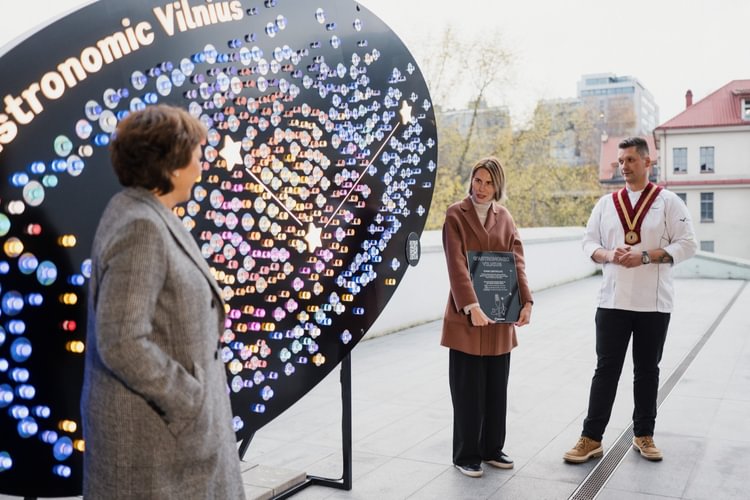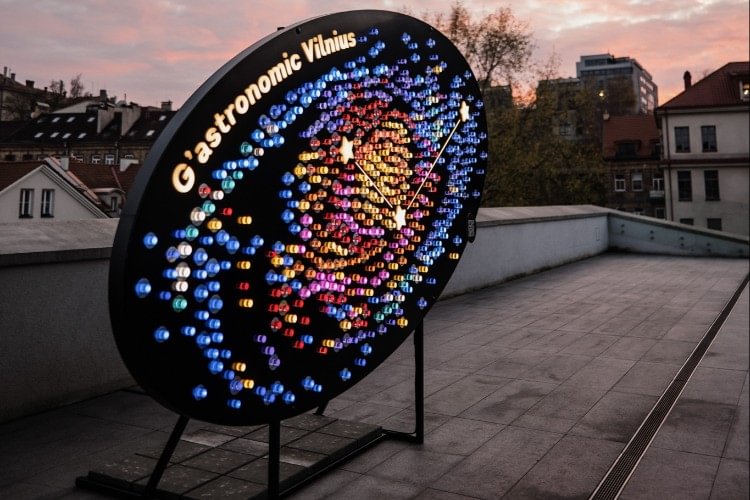G’ástronomic Vilnius now awarded by stars!
Vilnius is giving a symbolic gift and recognition to the city’s entire gastronomy ecosystem. These are three certificates of the Alpha, Beta and Nu Fornacis stars in the Fornax constellation, shining for lightyears in the universe above our beloved planet Earth.
This constellation shone in Vilnius as well, thanks to light artist Kotryna Čalkaitė’s G'astronomic Vilnius installation, which can be seen on the terrace of the MO Museum.
The stars are a part of the constellation Fornax visible in autumn and winter and are located 46.43, 177.99, and 371.05 lightyears away. The three purchased and registered stars—which can be seen on the Night Sky Guide app—are named “G’Astronomic Vilnius” and are intended “For restaurants that make up Vilnius’ gastronomic ecosystem, which shine so bright they’re worthy of real stars.”
Star Coordinates:
Alfa RA: 02h 04m 22.4s DEC: -29° 11' 14.8"
Beta RA: 02h 48m 54.5s DEC: -32° 18' 34.0"
Nu Fornacis RA: 03h 11m 54.4s DEC: -28° 53' 48.5"
How to find them?
Check out G'Astronomic Vilnius on "Star Registration – Night Sky" app!
Android: CLICK HERE
iOS: CLICK HERE
Star registration number: 4680-14884-2832006
What is a Star?
A star is mostly made of helium and hydrogen atoms that are attracted to each other. In the middle of this ball, gravity creates a strong pressure system. which causes the atoms to move closer and closer together. This movement gradually results in the formation of a ball shape. Essentially, stars are giant, glowing balls of gas.
HIP Number
The HIP number is used to identify the star in the Hipparcos Catalogue, which includes more than 100,000 stars and was completed in 2000.
RA/DEC Coordinates
RA is the abbreviation for right ascension, while DEC stands for declination. These coordinates indicate the current position of a star. The right ascension and declination correspond to the latitude and longitude of the Earth but relate to the sky. The equatorial grid is thus a geocentric coordinate system on the celestial sphere. In this rotating system, the centre of the Earth forms the mid-point of the calculations. It is used to indicate the positions of celestial objects. Zero longitudes are the moment in which the ecliptic crosses the Earth’s equator and thus reaches the vernal equinox.
Spectral Classes
Spectral classes are an important tool for stellar classification. Stars are distinguished by their temperatures and colours. Astrophysicists classify stars according to seven main spectral classes (0-blue, B-bluish-white, A-white, F-white-yellow, G-yellow, K-orange, M-red). The temperature of the stars decreases from blue (very hot) to red (less hot). The hotter a star, the brighter its surface.
Magnitude
The apparent brightness of a star is called the magnitude. The lower the magnitude, the brighter the star. In general, stars with a magnitude of up to six are clearly visible.
Distance
The distance of a star from Earth is measured in lightyears. One lightyear is equivalent to 9.4605 trillion kilometres or 5.8784 trillion miles.





